IDEX Online Research: U.S. Jewelry Price Inflation Moderates in March
April 22, 12
(IDEX Online) – Jewelry price inflation in the U.S. market continued to moderate in March, for the second consecutive month. Commodity prices eased – the price of gold fell by 4.0 percent in March versus February, along with all other key jewelry commodities – so some supplier pricing pressure was removed.
Retail jewelry prices in March were only slightly above February levels. Retail jewelry prices have been bouncing up and down for several months, so March’s modest inflation was a welcome respite from prior months.
Jewelry Wholesale Price Inflation Moderates
In March, the Jewelry Producer Price Index (JPPI) stood at 216.2, flat versus February’s 216.2; a year ago, the JPPI stood at 193.6. Here’s what this means:
· Wholesale jewelry prices were flat on a month-to-month comparison basis: March versus February 2012.
· Wholesale jewelry prices rose by about 11.7 percent on a year-to-year comparison basis: March 2012 versus March 2011. This is down from the inflation rates in both January and February.
· Wholesale jewelry prices were up 13.4 percent for the three months year-to-date 2012 versus the same period a year ago.
· The graph below summarizes the JPPI over the past two years.
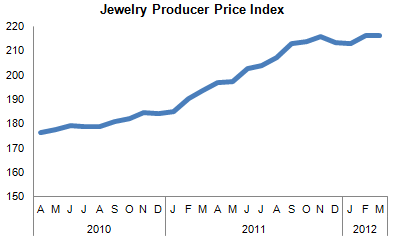 Source: BLS |
Jewelry Retail Price Inflation Moderates in March
In March, the Jewelry Consumer Price Index (JCPI) stood at 169.6 versus February’s 168.6; a year ago, the JCPI stood at 161.0. Here’s what this means:
· Retail prices of jewelry rose by about 0.6 percent on a month-to-month comparison basis: March versus February 2012.
· Retail jewelry prices rose by about 5.3 percent on a year-to-year comparison basis: March 2012 versus March 2011. The retail jewelry price inflation rate in March was the same as in February (+5.3 percent) and below January’s inflation rate of +6.8 percent.
· The graph below summarizes the JCPI over the past two years:
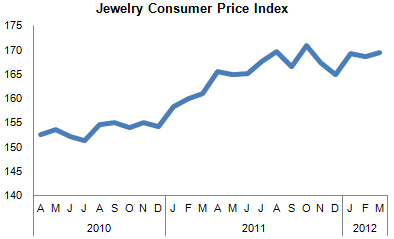 Source: BLS |
Supplier / Retail Inflation Rate Reflects Continued Disparity
While inflation may have moderated in the jewelry distribution channel, the chasm between jewelry retail prices and jewelry supplier and producer prices remained wide. Essentially, jewelry wholesale prices continue to rise faster than jewelry retail prices; this results in a margin squeeze among retail merchants. In March, jewelry supplier prices rose by 11.7 percent, more than double the rate of inflation of 5.3 percent for jewelry retailers.
March Jewelry Price Inflation High, But Moderating
While the February JPPI (wholesale) inflation rate was under 12 percent, significantly lower than prior months – and the lowest since the first quarter of 2011 – it is still very high compared to historic levels in the low-to-mid single digit range.
Further, the March JCPI (retail) inflation rate of just over five percent, while more moderate than some months in 2011, is also running ahead of its historic low-to-mid single digit level.
The disparity between supplier price inflation and retail price inflation that characterized 2011 has continued into 2012, though at a slightly lesser rate. Here’s how this disparity in inflation rates between producers and retailers affects the American jewelry industry: the margin squeeze that specialty retail jewelers have felt since 2009 continues to manifest itself.
After being somewhat stable in late 2011, commodity prices – gold, silver, platinum – moved higher in price in early 2012, though there was some moderation in prices during March. Precious metals prices correlate somewhat to the global economic climate since they are used in a wide variety of manufacturing processes. Further, geopolitical uncertainties cause investors to seek the historical safe haven of gold.
According to the latest forecasts from the OECD, the economies of most of the diamond-consuming countries are expected to grow modestly in 2012, though recent signs suggest a potentially more positive growth rate. This could lead to further disparity between retail jewelry prices and supplier prices. When the global economy strengthens, precious metals prices will likely rise as demand solidifies. This will intensify the current margin squeeze that retailers are experiencing, unless retailers are able to pass along higher product costs.
The table below provides detailed inflation rates in the U.S. jewelry industry for the following: 1) year-to-year price comparison for the month of March; 2) month-to-month price comparison for March versus February; and 3) three months year-to-date of 2012 price comparisons versus the same three-month period in 2011.
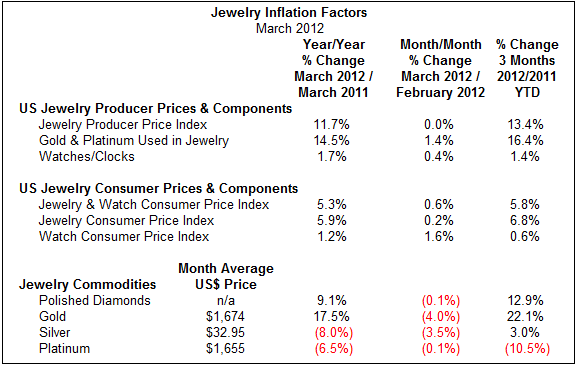 Source: Various markets |
Jewelry Suppliers’ Price Inflation Eases
On a month-to-month basis, jewelry suppliers’ prices appear to have been relatively stable for the past six months or so, even after a small upward move in February that appears to have been a one-month phenomenon. The March JPPI index of 216.2 is at the top of the range of the JPPI index for the past six months of 213 to 216, and it was exactly the same level as in February. Thus, month-to-month comparisons of jewelry suppliers’ prices were flat.
March’s jewelry supplier price inflation rate of 11.7 percent, year-to-year, was modestly lower than 2011’s inflation rate of 13.9 percent. However, it was far above the jewelry supplier inflation rate of 9.3 percent for the full year 2010, and it was multiples above 2009’s supplier inflation rate of 3.3 percent.
The graph below summarizes year-over-year jewelry supplier price inflation on a monthly basis.
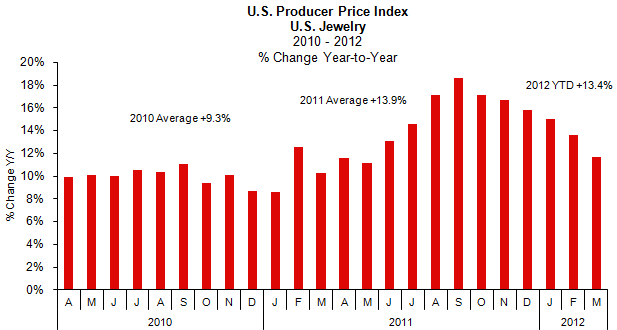 Source: BLS |
Higher Precious Metal Prices Continue To Drive Inflation
Jewelry suppliers’ prices of precious metals jewelry rose by 14.5 percent during March 2012 versus the same month a year ago. This was notably above jewelry suppliers’ overall inflation rate for all jewelry and watches of 11.7 percent for the month, but it was down from January’s 20 percent inflation rate and February’s 16 percent inflation rate for precious metals
On a month-over-month basis, jewelry suppliers’ prices for precious metal jewelry rose by 1.4 percent in March versus February, despite the fact that commodity prices of gold, silver, and platinum fell on a month-to-month basis in the same period.
On an annualized basis, March’s monthly inflation rate would suggest that suppliers’ jewelry prices could rise by 17 percent or so. However, IDEX Online Research does not put much emphasis on monthly price changes: they simply are not meaningful because they can swing dramatically between months. Further, while the economics of supply and demand have some impact on precious metals prices and inflation, the financial markets are responsible for most of the wild gyrations that affect precious metals prices.
The graph below compares the jewelry supplier inflation rate for precious metals jewelry (gold columns) versus the overall jewelry supplier inflation rate for jewelry (red columns). These comparisons are year-to-year.
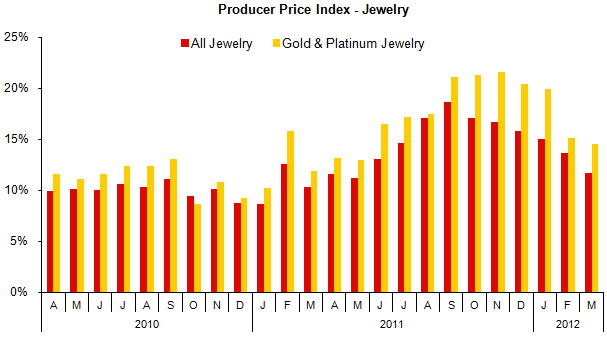 Source: BLS |
Watch Price Inflation At Supplier Level Up Slightly In March
Watch prices at the supplier level in March showed a modest 1.7 percent gain when compared to the same month a year ago. This level of watch price inflation is an upward deviation from the trend since last August, after a one-month spike in mid-summer 2011.
On a month-to-month basis – March versus February – supplier prices of watches were up 0.4 percent. This is an annualized rate of just under 5 percent.
In recent months, watch demand and watch sales in the U.S. market perked up; thus, we would expect to see watch prices rise over the longer term as suppliers raise their prices to compensate for higher commodity prices.
The graph below shows year-to-year supplier price inflation for watches for the past twenty-four months.
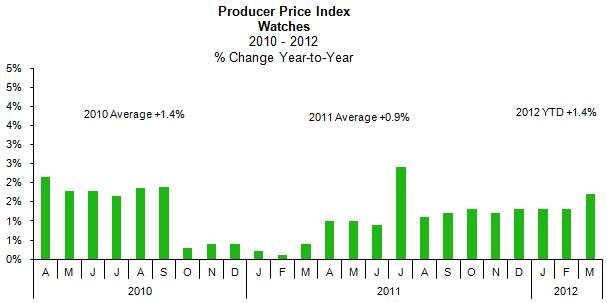 Source: BLS |
Jewelry Retail Prices Moderate in March
Jewelry retail prices have been climbing since late 2010, driven by both stronger consumer demand and higher supplier prices. However, there have been month-to-month pauses in price increases along the way. After a pause in December 2011, retail jewelry prices rose in January 2012, paused in February, and rose again in March, though at a more moderate level than in 2011.
When compared to February 2012, retail jewelry prices in March rose by 0.6 percent. In part, this may be due to strong February jewelry sales during the Valentine’s Day selling period. Demand for jewelry has been more volatile in the past several months.
When demand is strong, jewelers tend to push retail prices higher. But at any sign of abating demand, inflation seems to stabilize, rather than increase. Some jewelers report that consumers are highly sensitive to price changes, and therefore demand waxes and wanes, depending on the current retail price. Perhaps this helps explain the recent lack of a clear trend for retail jewelry prices in the U.S. market.
On year-over-year basis, March’s retail jewelry prices – all categories of merchandise – rose by 5.3 percent over March 2011. This was a more modest increase than many prior months’ gains. It is important to note, however, that the use of the word “modest” for March’s 5.3 percent gain may be misleading: retail jewelry price inflation has averaged about two percent over the past 25 years since the BLS began keeping jewelry industry statistics.
The graph below summarizes year-to-year retail jewelry price inflation in the U.S. market.
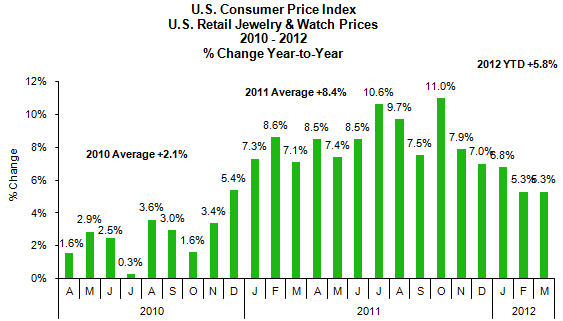 Source: BLS |
Watch Retail Prices Show Modest Inflation
Retail and supplier prices of watches have tended to move together, both on a month-to-month basis and a year-to-year basis, over the past few years.
For the month of March 2012, retail watch prices rose by a moderate 1.2 percent from the same month a year ago. When compared to the prior month (February 2012), watch prices in March rose by 1.6 percent. There appears to be some short-term price inflation, perhaps driven by strengthening demand for watches.
The graph below compares the year-to-year inflation rate for jewelry and watches (green bars), jewelry only (red bars), and watches (gold bars).
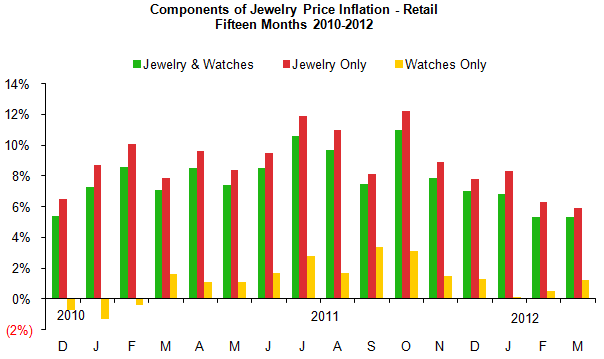 Source: BLS |
Jewelry Inflation Outlook: Moderating Inflation in 2012
Our outlook for jewelry price inflation remains unchanged: jewelry prices are expected to move higher at all levels of the distribution channel throughout 2012 and perhaps beyond. But, the rate of inflation is expected to be below 2011’s torrid pace, both at the supplier level and at the retail level.
It would be easy to forecast inflation for the jewelry industry if all of the commodities involved in the forecast were used exclusively by the jewelry industry. While that may be the case for polished diamonds, precious metals are used by a number of other industries. Further, gold is an international currency that plays in a financial arena of its own.
· Jewelry Industry Long Term Outlook – Demand from emerging economies such as India and China will help fuel sales of jewelry in those nations. Thus, the longer-term outlook for jewelry demand is positive.
· Global Economic Outlook for 2012 – The latest OECD data points to moderate economic growth with a “positive” outlook for stronger growth in the next 12-18 months.
· Financial Markets Outlook for 2012 – With continued volatility in the world’s stock markets and uncertain valuations related to stocks, bonds, and other hard assets, investors may seek the safe haven that gold offers. Despite predictions by others that gold will hit $2,000 this year, we are not ready to embrace those forecasts. This level would represent a mid-teen price increase. We see investor movement toward income-producing assets, and a move away from assets that do not produce income or an inflation hedge, such as gold.
The bottom line: inflation is headed higher over the longer term, but perhaps at a more moderate rate. Jewelry suppliers and retailers should use periods of weakness in commodity prices to add to their inventory. a